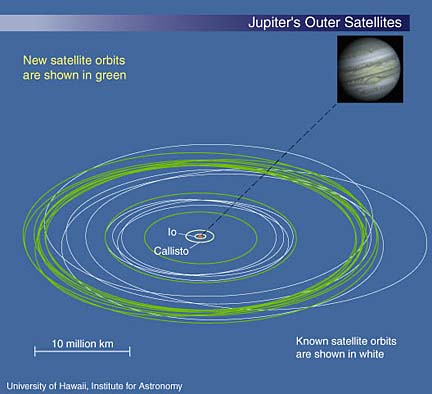Advertisement - Click to support our sponsors.

Eleven new satellites orbiting Jupiter and two of the most bizarre multiplanet systems ever found are among the latest discoveries by scientists working on Mauna Kea. UH astronomers
discover 11 more
moons for JupiterMainland scientists also find
two multiplanet systems, using
telescopes atop Mauna KeaBy Helen Altonn
Star-BulletinUniversity of Hawaii astronomers detected 10 new moons in Jupiter's outer "irregular" satellite system and another one that was identified in 1975, then disappeared.
Addition of the 11 satellites to Jupiter's map makes a total of 28 orbiting the planet. The UH Institute for Astronomy team, led by planetary astronomer David Jewitt and graduate student Scott Sheppard, hopes to boost the number by another 100 in continued research.
The group, including astronomers Yan Fernandez and Eugene Magnier, discovered the 10 new satellites and missing moon by searching the region near Jupiter with the 88-inch UH telescope on Mauna Kea.

Astronomers were lucky to detect one or two planetary moons every decade until the advent of huge cameras on telescopes that provide a big field of view, Jewitt said. "To suddenly find 11 of these things in one shot means we're onto something."The group hopes to work with a larger telescope that will enable them to identify fainter objects. As they detect more moons around Jupiter, they can begin to discern patterns. "With 100, we can do some serious work," Jewitt said. "We can really understand these bodies."
Mainland scientists discovered the two stellar systems with the Keck I telescope on Mauna Kea and the Lick Observatory telescope in California.
"One system calls into the question the very meaning of the term 'planet,' " astronomer Geoffrey Marcy of the University of California, Berkeley, said today at an American Astronomical Society meeting in San Diego.
The second system has two planets locked in synchrony around their star, with orbital periods of 60 and 30 days.
"These two resonant planets seem to be humming in harmony," said Debra Fischer of UC-Berkeley.
The systems previously were known to contain one planet but now appear to have two planets, each orbiting a central star.
One system is around the sun-like star HD 168443, which is 123 light years away in the Serpens constellation, the scientists said. Orbiting it is a massive planet and another object at least 17 times more massive than Jupiter -- the largest planet orbiting the sun.
Paul Butler of the Carnegie Institution of Washington said it isn't clear whether the "bulky beast" is a planet, a dim failed star (called a brown dwarf) or some unidentified astronomical object.
The UH astronomers hope that patterns of irregular satellites orbiting Jupiter will begin to tell them the origin of the solar system, Sheppard said.
They believe Jupiter formed earlier and much faster than Earth and captured passing asteroids, which are irregular satellites, he said. Some orbit the planet in a direction opposite to Jupiter's rotation, he said.
The origin of the irregular satellites has been a mystery since the first ones were discovered 40 or 50 years ago, he said.
"What's exciting," Jewitt added, "is that very likely these bodies were captured by Jupiter when it was very young, maybe less than 1 million years in age."
UH Institute for Astronomy